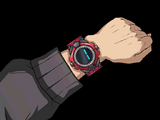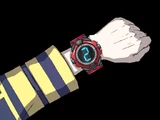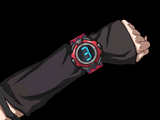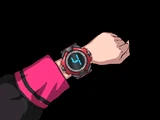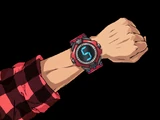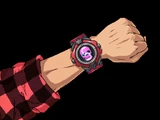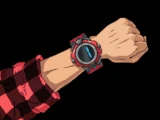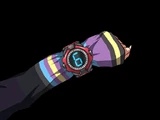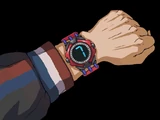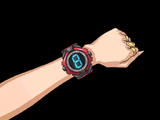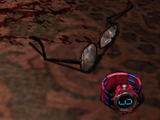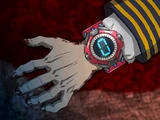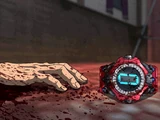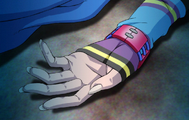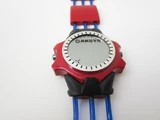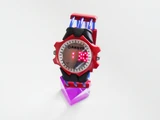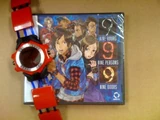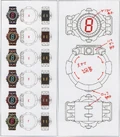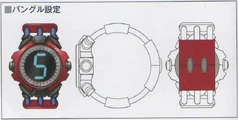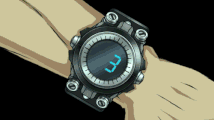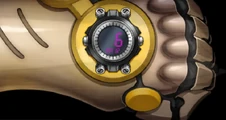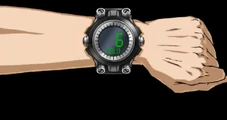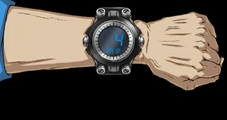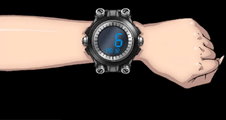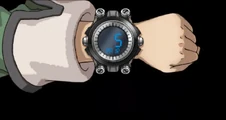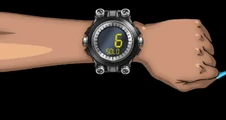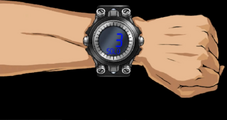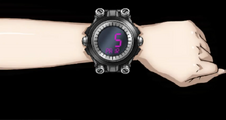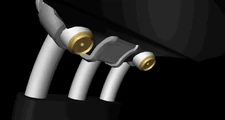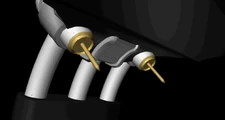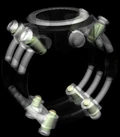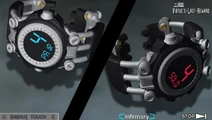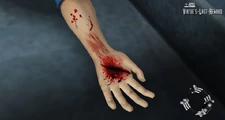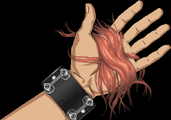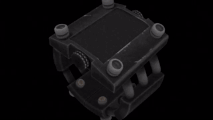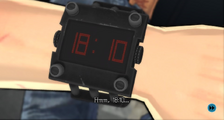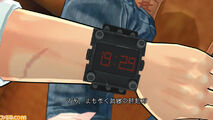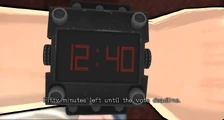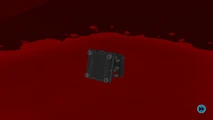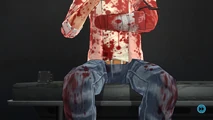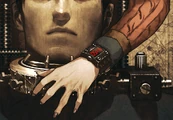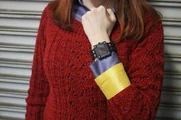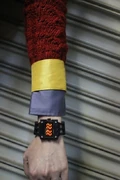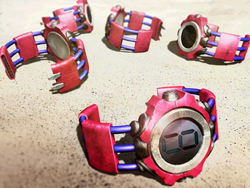
The survivors' bracelets detach at the end of the Nonary Game.
Bracelets are important objects used in the Nonary Games and the Decision Game. They are worn on a player's left wrist. In the Nonary Game, they act as judge and executioner. Bracelets enforce the rules of each Nonary Game, and make anyone who breaks them die. In the Decision Game, they inject the participants with a drug every 90 minutes that makes them pass out and forget everything that just happened. They also act as a real-time clock.
They are thick and have an LCD screen similar to a digital watch. There is also a button on each side of the display. They do not have a clasp to remove, and anyone who tries to break or remove the bracelet will be considered breaking the rules.
While "bracelet" is a broad term, each game's specific bracelet functions differently. One similarity in 999 and Virtue's Last Reward, however, is that both types of bracelets measure the electric impulses the heart makes, called EKGs. When it stops picking up on impulses, the bracelet will come off. The only other way to get the bracelets off is to win the game and escape from the playing facility.
Nine Hours, Nine Persons, Nine Doors
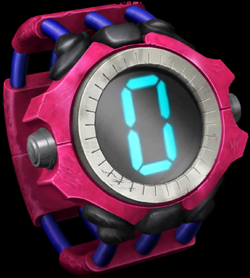
The bracelet, as it appears in 999.
In the First and Second Nonary Games, participants woke up with a bracelet attached to their left wrist. On the LCD display is a number, 1-9 for each participant, and the color of the bracelets is a reddish pink. These numbers function as the participant's ID throughout the game. The bracelets were originally created by Cradle Pharmaceutical member Teruaki Kubota.
In order to progress through the numbered doors, participants in the Nonary Game must create the digital root of the door they wish to go through. As each numbered door can only have a minimum of 3 people and a maximum of 5, they have to use those restrictions when creating the digital root.
After going through the door by registering each bracelet at the door's RED, a detonator in the bracelet is activated once the door's threshold has been crossed. Participants have 81 seconds to find the DEAD on the other side of the door. If it is not found within that time, the bomb within the participant's stomach will explode, killing them. In actuality, a majority of the bracelets used in the Second Nonary Game contained no such detonator, although this fact was not discovered until the surviving players managed to escape. The only bracelets that were known to contain a detonator were Teruaki Kubota's and Nagisa Nijisaki's.
The buttons on the side of the bracelets do nothing, unless they are pressed in a specific order. In doing so, the LCD display will flash a series of numbers that appears as a code, this appeared in the Safe Ending and True Ending.
Values
| Player | Bracelet symbol | True value | Notes | Codename origin |
| Ace (Gentarou Hongou) | 1 | 1 | "Ace", in a 52-card deck, has a face value of 1. | |
| Snake (Light Field) | 2 | 2 | One of two 2 bracelets. | "Snake Eyes" is what rolling 2 dice and getting 2 "1"s is called. |
| Santa (Aoi Kurashiki) | 3 | 9 | Secretly functions as 9. Always paired with June's true value (0) to cancel both of them out. One of two 9 bracelets. | "San" is Japanese for 3. |
| Clover Field | 4 | 4 | Represents a lucky four-leaf clover. Clover also uses her real name. | |
| Junpei Tenmyouji | 5 | 5 | Junpei does not use a codename since Akane inadvertently revealed it to the group before the consensus to use codenames was made. If he did, it would probably be Hand, Star or Penta. | |
| June (Akane Kurashiki) | 6 | 0 | Secretly functions as 0. Paired with Santa's true value (9) to cancel both of them out. | June is the sixth month of the year. |
| Seven | 7 | 7 | Seven opted to use just the name of the number he used. | |
| Lotus (Hazuki Kashiwabara) | 8 | 8 | Lotuses typically have 8 petals. | |
| Teruaki Kubota | 9 | 9 | One of two 9 bracelets. | Kubota does not partake in the codename consensus. |
| Kagechika Musashidou | O (letter) | 6 | Letter O is both the 15th letter of the alphabet as well as the hexadecimal value 24. Both 15 and 24 have a digital root of 6. | |
| Nagisa Nijisaki | 2 | 2 | One of two 2 bracelets. |
Virtue's Last Reward
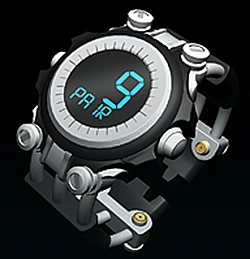
The bracelet used in the AB Game.
In the Nonary Game: Ambidex Edition, the bracelets, while visually similar, are different in functionality. These bracelets are black. This version of the bracelets were created by Sigma Klim.
Participants once again wake up with the bracelet attached to their left wrist. The LCD display has a 3, and the words "PAIR" or "SOLO", while colored in red, blue, or green text.
- The number displayed is the wearer's current Bracelet Points (BP). Participants gain and lose BP by playing the AB Game. The goal of the game is to get 9 or more BP to open the Number 9 Door.
- "PAIR" and "SOLO" refers to the participant's status in the next AB Game. "PAIRS" are two people who share the same destiny--as in, they vote together, and lose points together. "SOLOS" work alone. When going through Chromatic Doors, each PAIR must be with a SOLO.
- The colors are an incredibly important aspect, as they decide the choices of who can go through which color of Chromatic Door. The colors can be as followed: Red, Green, Blue, Magenta, Yellow, and Cyan. Combining the colors of the bracelets is what's needed to go through the Chromatic Doors.
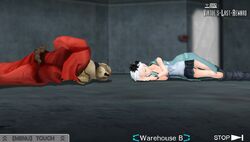
K and Phi sedated by the Soporil in the bracelet as punishment.
Pressing the buttons on the sides of the bracelets brings up a timer. This timer represents how much time is left before the next set of Chromatic Doors open. Once the timer hits 0, the doors open and will stay open for 5 minutes. Anyone who goes through a door that their color doesn't make, or is outside when the doors close, will be punished. The needles on the underside of the bracelet will inject the wearer with Soporil. Nine minutes later, the muscle relaxant tubocurarine is injected, which stops the respiratory muscles by numbing them and kills the participant.
As the bracelet reads EKGs, anything, such as aluminum foil, that blocks out the electric waves can trick the bracelet into reading that the participant has died, and will slip off. However, many of the participants, except for Luna, are not aware of this. She used this method on Quark, who collapsed because of Radical-6. The Aluminum foil was found in the Crew Quarters.
Although it's not mentioned in the game and, instead, only in the Secret Archives, the bracelets have an important feature. As soon as it's put on, a needle in the underside activates and inserts itself into the wearer. That doesn't necessarily mean that it injects a drug, only that it activates and pierces the skin. This may be how Zero Sr. ensured that all participants would be infected with Radical-6, although it is just as possible that the bracelets have nothing to do with Radical-6, asides from their clocks being synchronized to Radical-6 time.
K's bracelet
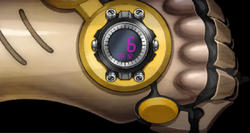
K's bracelet.
At first glance, K's bracelet seems different from the others. Specifically, it appears to be attached to his suit. Although the design is slightly different, it is not a part of his suit: The bracelet is attached directly to his wrist, with the face looking out through a hole in his armor. Just like the other bracelets, it will only come off when he escapes, or when his heart stops beating.
Zero Time Dilemma
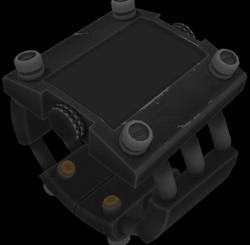
The bracelet used in the Decision Game.
Zero Time Dilemma also makes use of bracelets. Unlike its predecessors, its bracelets are square shaped. They also function as actual watches and tell the time by pressing each button on the side of the bracelet simultaneously.
It is unknown if these bracelets measure EKGs, due to the fact that the bracelets don't unlock after death. There also doesn't appear any incentive for players to collect the bracelets of others. Nothing happened to the bracelets of participants who have died during the game (Carlos' bracelet didn't unlock even though it fell off of his severed hand) which implies that bracelets only unlock after escaping.
Every 90 minutes, these bracelets release an anesthetic (possibly Soporil) that forces the players to get knocked out, and another unknown drug is injected after that, so the players lose their memories of the last 90 minutes after they awaken.
There's also a third drug in the bracelet: tubocurarine. This seems to have been used as a reference to Virtue's Last Reward. In the Power Room, the door will only open if two people play the Ambidex Game. Just like Virtue's Last Reward, if a player's BP drops below 0 BP, they are injected with tubocurarine and die. The loser gets injected with tubocurarine without any Soporil.
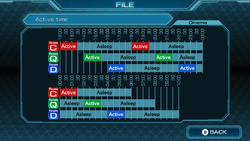
THe times for each team.
Later in the game, it is revealed that the time of the bracelets for each team is different. Using C-Team as a base:
- C-Team:
- Q-Team: 2 hours after C-Team
- D-Team: 4 hours after C-Team
It's also proven that the needles in the bracelet only activate every 90 minutes and then retract when the participants awaken, instead of it being "permanently activated" in Virtue's Last Reward. Because of this, if someone can slide something thin and hard under the bracelet (such as a card from the Transporter Room), it will prevent the needles from working.
Trivia
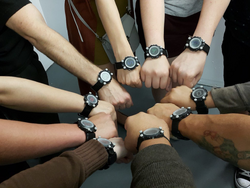
The bracelets in Zero Escape: Trust on Trial.
- Aksys Games collaborated with SCRAP Entertainment to create a real-life Zero Escape styled escape-the-room called Real Zero Escape: Trust on Trial. In it, participants were given Virtue's Last Reward bracelets, but numbered 1 to 9 like in 999.
- Aksys Games distributed real-life versions of the bracelets with preorders of 999, Virtue's Last Reward and Zero Time Dilemma. All of them function as watches. The Virtue's Last Reward watches were unique since each one either had a green, yellow, blue, or red display.
- In 999, there is only one instance during the game when a group of five goes through a numbered door. This occurs if Junpei chooses Door 5, which forces Ace, Santa, Clover, June, and Lotus to go through Door 4.
- In the pre-production stages of 999, the bracelets themselves were going to explode, instead of tiny bombs in the players' stomachs.[1]
- In 999, when searching for the DEADs, an image of a pink skull appears on the bracelets.[2] This pink skull returns in the Nonary Game: Ambidex Edition on the scoreboard whenever a player dies.[3]
- In Virtue's Last Reward, Zero III claims that the bracelet colors are shuffled "totally random". However, considering the purpose of the AB Game and the AB Project, it is unknown if this is actually true.

